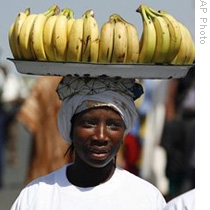Nairobi
28 August 2009
 |
| A Senegalese banana vendor in Dakar, Senegal (file photo) |
Leading plant health scientists meeting in Arusha, Tanzania says nearly half of the banana-growing regions of sub-Saharan Africa have been infected with one of the world's most invasive diseases for which there is no cure.
The banana bunchy top disease causes all the leaves of the banana plant to sprout from the top and stunt the plant's growth. Several attacks of the viral disease were recorded in central and southern Africa last year. A recent survey suggests the disease has now taken root in 12 countries in central and southern Africa, including Congo Kinshasa and Brazzaville, Gabon, Angola and Malawi.
The scientist who led the survey, Lava Kumar of the International Institute of Tropical Agriculture, tells VOA that it is as if the plant world has developed its own version of HIV, the virus that causes AIDS in humans.
"It is a very silent killer. It can enter your farm and it stays quietly there," he said. "And suddenly, it exhibits its symptoms. By the time you realize [it], your whole farm is infected with the problem."
Kumar says a plant infected with bunchy top disease does not die, but it is unable to produce any fruit.
A survey conducted earlier this year showed another disease that has been devastating banana crops in Uganda and Congo Kinshasa for years has infected numerous farms across east Africa. The disease, banana bacterial wilt, kills off plants and makes the fruit inedible.
A crop specialist at Biodiversity International, Eldad Karumura, says like the banana bunchy top disease, bacterial wilt is spread by insects and can wipe out yields because few varieties of bananas have any resistance.
"By 2006, it was already in five other countries, including Kenya, Tanzania, Rwanda and I think it is about to enter Burundi," said Karumura.
Scientists say farmers need to take drastic measures now to stop the spread of the disease and to avert a disaster. They recommend excavating entire banana fields and treating them with pesticides or burning the plants.
In several countries, both diseases already appear to be at play. The crisis is threatening to worsen hunger and deepen poverty for some 30 million people in Africa, who rely on the banana for food and income.
Scientists say they are working to raise public awareness of the diseases and to develop national and regional strategies that can help affected countries respond to the threat.